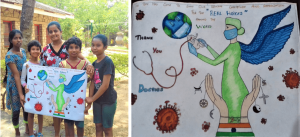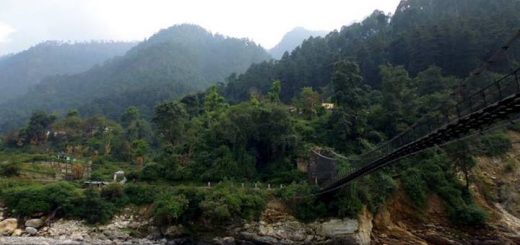Creating Hope, One Childhood at a Time: SOS Children’s Villages, India
I hope this post finds you safe and well, wherever you are. I’d like to share with you one of the most hope-filled and life-affirming places I’ve ever been to. It isn’t somewhere on the other side of the globe, but in my old neighborhood in Bangalore. Back when I was around 18 and a law student, I passed by the SOS Children’s Village every day on my way home. I knew they were doing some good work, but I had no idea about the extent or nature of it. My aunt had long been a sponsor to one of the kids there, a bright young girl I’d met a few times. I’d heard great things about the organisation from her. A few years ago I walked into the Bangalore centre to have a closer look and it exceeded all my expectations. I doubt I’ve known a more deliberately designed and wholesome, nourishing environment for kids to grow up in.That’s when I decided to begin sponsoring two kids and I’ve been seeing firsthand on every visit how well they are being taken care of. It costs INR 900 (USD 12) per month to sponsor one child, well affordable to many of us far more privileged than abandoned children.
Here is the link with more information on sponsoring a child: https://www.soschildrensvillages.in/sponsor-a-child
For one-time donations: https://www.soschildrensvillages.in/donate-now

Children at SOS Bangalore with their artwork as a tribute to health-workers everywhere
While the world reels under Covid-19, a larger global disaster has been playing out under our noses for ages. Thousands of children have been dying every single day of hunger and malnutrition. But hunger isn’t contagious and doesn’t affect the rich, so this alarming information stays well outside the headlines and our collective awareness. In developing countries, almost 5 million children under the age of five die of malnutrition-related causes every year (Source: FAO). If that saddens you at all, I hope it moves you to act in whatever way is within your reach. Like someone said, hope is born of participation in hopeful solutions.
Last week, I spoke to Mr Sudarshan Suchi, Secretary-General of SOS Children’s Village India about the work SOS is doing in India and its main challenges in light of the Covid-19 pandemic. Read on for some insight into the workings of this organisation, how the women undergo a 2-year training before being appointed as SOS mothers, and how the kids are handling the lockdown:
Can you share with us the story of how SOS Children’s Village was formed? And please tell us about your role in the organisation and what drew you to this work.
We are part of a 70-year-old legacy in nurturing young lives. Our commitment towards caring for children in need is rooted deep in history. SOS India is a part of SOS Children’s Villages International, which was founded by Dr Hermann Gmeiner in 1949 to protect and shelter children who were rendered parentless because of World War II. The first SOS Children’s Village was established at Imst, Austria with a simple, innovative concept that remains today: children without parental care need a personal bond with a caregiver in a family-like environment. Seven decades later, SOS Children’s Villages is active in 136 countries and territories around the world, helping hundreds of thousands of children each year through alternative care, family strengthening, schools, health centres, and other community-based work.
The term “co-worker” is most used to describe all of us in Team SOSCV India! And as the term suggests – I am one of the co-workers and head of the family in some ways both in letter and spirit. My role is to understand the Goals; Challenges; Needs and Burdens of my team and support them in sustaining the Missionary Zeal which is required in this work in normal times – and is so much more relevant in these COVID Challenged times. What drew me to this work is – “Family” – spirit of family and relationship underlying anything and everything done here as a defining principle. Furthermore, the idea that any and every effort will bring quality care to children directly is very energizing and motivating. I believe in direct action and implementation and this organisation is all about that.
I’ve been to the Bangalore chapter of SOS a few times and I can attest that it is truly a wonderful space for children to grow up in. Can you tell us more about the Bangalore SOS village and when/how that came into being? What went into the making of such a wholesome environment for the kids to grow up in and feel at home?
SOS Children’s Villages of India was founded in 1964 by an ambitious set of social reformers with one single dream. A dream of great magnitude and even greater importance. A vision to ensure that NO child in India slept on a hungry stomach, without love from a Mother, aloof from siblings, without a family and home to call his/her own.
During the 1990’s, Bengaluru was seeing tremendous growth in terms of economy and industrial development, resulting in attracting a lot of people from the rural areas. Due to this increase in population, the urban city started witnessing a rise in its poverty rates. This left families with limited resources, resulting in hundreds of families abandoning their children, rendering them parentless and orphaned. In 1990, SOS India decided to open up yet another Children’s Village – SOS Children’s Village Bengaluru to make sure that these children didn’t experience the journey of life alone.
It is widely understood that a stable, nurturing environment lays the foundation for a child’s healthy development. Unfortunately, not every child has this advantage. Without the stability of a family, a child faces an increased risk of malnutrition, violence, exploitation and other life-threatening circumstances. SOS Family Like Care (FLC) provides a loving home to parentless and abandoned children to grow up within the stability and security of a family, and a supportive community. Children grow up together as brothers and sisters under the care of an SOS Mother – helping create an everlasting bond of togetherness. Children are provided holistic care and opportunities that empower their future and ensure successful mainstreaming into the society.
What are the main challenges faced by SOS in India these days? With the pandemic have you seen a drop in the number of people coming forward to be donors? How does the organisation spread awareness and encourage people to come forward as donors?
The main challenge faced by us these days is to ensure that the care of children is sustained in the same spirit and quality as always – with minimal disruption respecting the trauma that they have already come from and preventing any additional trauma. First and foremost, being grounded in four walls all the time, they need active and positive engagement – and ways and means of these. Going further, the mothers who care for them need all their energy and enthusiasm sustained along with the capacity to innovate (Though surprisingly this has come at ease for each mother – such I guess is the power of motherhood). Not the least is to keep up the morale of the team which is taking care – of their safety and the safety and security of the children. Fundraising and rations etc. are a challenge but less in comparison with the above.
SOS India has a fundraising mix, and a key part of this mix is in-person fundraising, or through events and meetings with people. So, yes this unprecedented situation has made us completely change the way we work. Connecting online seems to be the only way, going forward. Having said that, I genuinely feel that us Indians have large hearts. We love to help the unfortunate, it’s ingrained in our DNA. It’s who we are. And now, even more so. In the near future, I see us working a lot with online influencers, with volunteers and brands/people invested in impact.
Where does SOS find these children and the women who take care of them?
In the early days, children did become a part of the organisation directly, wherein at times people left newborn babies at the village doors. Given the circumstances we live in, the government has very strict rules and laws for child protection. Hence, all the children in our villages are allotted/assigned to us by the Child Welfare Committee (CWC which is based in every district of India).
An SOS mother raises a generation of children as her own and must be able to meet their physical and emotional needs from infancy right up to adulthood. SOS mothers are chosen carefully to ensure they are capable of raising an SOS family in the long term. They are reached out to and identified with a very effective referral system of the existing mothers and field teams and communities. The candidates are then put through a rigorous two years training, capacity building and induction to enable them thoroughly to undertake the role as a lifetime’s journey. Which is why the attrition in this role – perhaps one of the toughest roles among all development professionals – is minimal or almost nil! Which says a lot, not just for the process but for the women who dedicate and immerse themselves for a lifetime’s journey.
Training for an SOS mother takes up to two years and includes three months of theoretical training (on subjects including education, counselling and child psychology, housekeeping, nutrition and conflict resolution) conducted by social workers and child care professionals. This is followed by 21 months of practical training working in an SOS Children’s Village as an “SOS Aunt”. This lengthy training period prepares them for the reality of becoming an SOS mother. Every day, SOS mothers ensure that the physical and emotional needs of her children are met and every child in her family is happy and feels that s/he belongs.
Is there a helpline the general public can call when they see a child in distress or abandoned to live on the streets?
Yes there is a toll-free helpline number provided by the Child Welfare Committee (1098) for the protection of children. In case you ever happen to come across a distressed child please call on this number and inform.
Would you agree that hunger/starvation is the larger pandemic that has always been around but largely ignored because it doesn’t affect the privileged and isn’t contagious?
Yes, I would totally agree. In fact, taking the example of the current COVID-19 situation, the larger fear for the poor in India is to die of hunger than coronavirus. At least 90% of India’s workforce is employed in the informal sector, according to the International Labour Organization, working in roles like security guards, cleaners, rickshaw pullers, streets vendors, garbage collectors and domestic helps. Most do not have access to pensions, sick leave, paid leave or any kind of insurance. Many do not have bank accounts, relying on cash to meet their daily needs. Many are migrant workers, which means that they are technically residents of a different state to the one where they work. Even though the government is trying their best to reach out to all these people, but far more than getting infected by any deadly disease, they fear having to sleep hungry.
Many of us are privileged to sit at home and watch television, spend time with our families, play with our kids. But the situation is different for millions of vulnerable children and families in the country, who’s first real concern will always be about food, shelter and basic essentials.
For someone would like to be a sponsor/donor henceforth, can you share with us the online procedure to become a donor?
The online procedure to extend support towards SOS India is through donation and sponsorship. People can support us in multiple ways; some sponsor one child fully, while some may sponsor only education for one or more children, while some may sponsor an entire Family home (sponsoring 10/12 children and all their expenses), and then there are few very generous donors who sponsor more than one family home.
The way I see it, it’s the thought and small actions that count. We just want to make every Indian feel the pain a homeless child feels. And to do anything in their capacity to help.
Because, we can do so much more, only with the support of our donors.
Donate now – https://www.soschildrensvillages.in/donate-now
In general, how are the SOS kids handling the pandemic and lockdown scenario?
To be frank, we are witnessing different reactions from all the children. However, it makes me so proud to say that a lot of these kids have truly taken this period in the right spirit. They are loving this time home with all their siblings, Mother. They can now play games, climb trees, and just enjoy being a child. A lot of them are rediscovering their talents, or some are even discovering hidden talents. There is a sense of bonhomie, a cheer, because for kids, this time being indoors with family, is truly what many of them may have wished to in their lives. Kids are learning new dance forms, they are challenging each other to do workouts, yoga, DIY projects, singing songs, cooking and baking savouries. The ones in higher classes and colleges, are doing all of this over and above their studies. Their online classes have started, so many are adjusting to the new technology along with the class. We do post regular updates from all our villages on our social media, so that our donors and others can stay connected.
Is there anything else you’d like to share with our readers who might be considering becoming a donor/sponsor of a child at SOS?
Yes definitely, there are millions of children who have lost parental care and survive each day on their own. This number is on a steep rise. Without parents, these abandoned, vulnerable children face a life filled with multiple violations of their rights and a childhood robbed of memories, love, care and a loving home. At SOS Children’s Villages, we provide homes to these children so they can grow up in the warm embrace of a family until they are capable of living independently as contributing members of society. Our supporters are the backbone of this mission. And we will need their generosity and wholehearted support to keep facilitating countless miracles in the lives of thousands of children and vulnerable families.
For more on SOS Children’s Villages India and their work, find them on Instagram SOS Children’s Villages India and Facebook SOS India
As always I’d love to hear from you, so feel free to drop a comment below. Stay safe and well 🙂
Liked this post? PIN it for later!






I have gone through the queries of the Donor about the activities of SOS INDIA and your comprehensive reply about our Vision and mission which is really wonderful and thoughtful. Hats off to your endeavour and expertise !! Best wishes. Ashis Ray
(DADA).
Thank you so much Ashis 🙂 Best wishes to you as well
Thanks Namita for this Inspiring Blog and also creating Awareness for such a noble and unique organization. Loved your interview with Mr Sudarshan Suchi of SOS…Very insightful indeed
I too am a very big admirer of this SOS village from 1996. Kudos to you for creating Hope and wishing All The Best for Hopeful Solutions.
May Your Tribe Increase
Glad I heard about this organisation through you so thanks to you!
Wonderful article that I am happy to endorse having visited the organisationb villages and family strengthening projects last January.
Thank you Kristjan! Glad you enjoyed reading and I’m sure you loved visiting the children’s village as well 🙂 Hope more people hear about it and help out in whatever way they can
Good My ward is learning so much